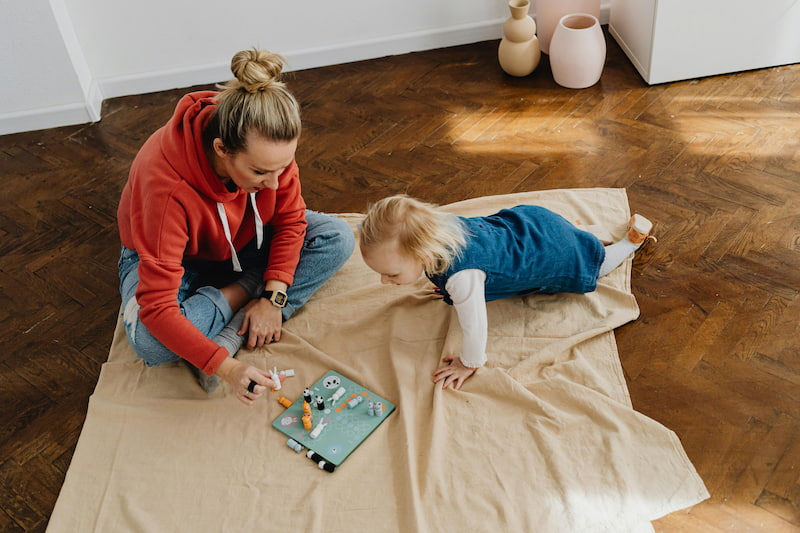Parents’ Guide to Teaching Preschool & Kindergarten at Home
- Aria Dana

- Sep 10
- 5 min read
Parents’ guide in teaching preschool and kindergarten at home. Know the effective learning materials for language & literacy, math, science, social-emotional skills, and arts to support early childhood education.
Table of Contents
Is Early Childhood Education Important?
Early Childhood Education (ECE) is important for promoting cognitive, social-emotional, and academic development in children. Research indicates that quality ECE programs significantly enhance children's readiness for school and their long-term success.
Key reasons why ECE matters:
Cognitive Development
ECE promotes essential skills such as problem-solving, memory, and language acquisition, preparing children for future academic challenges (Olanrewaju & Omeghie, 2024).
Programs like Head Start have shown success in improving early academic skills, particularly for children from low-income families (Groenhof, 2023).
Social-Emotional Growth
ECE environments teach children to share, cooperate, and communicate, fostering confidence and empathy (Olanrewaju & Omeghie, 2024).
Children learn to manage emotions and build relationships, which are critical for their overall well-being (Abdussammed., 2024).
School Readiness
Early education helps children adapt to structured learning environments, instilling routines and expectations necessary for success in kindergarten (Gyekye-Ampofo & Opoku-Asare, 2023).
Skills in reading, writing, and critical thinking are developed, laying a strong foundation for future learning (Olanrewaju & Omeghie, 2024).
Creativity and Exploration
Play-based learning in ECE encourages curiosity and innovation, allowing children to develop fine and gross motor skills through exploration (Gyekye-Ampofo & Opoku-Asare, 2023).
Long-Term Benefits
Studies indicate that children who receive quality ECE are more likely to succeed academically and professionally later in life (Olanrewaju & Omeghie, 2024).
Early intervention can mitigate learning difficulties, particularly for children with special needs (Abdussammed., 2024).
Even at home, parents can provide early learning experiences through play, reading, problem-solving activities, and interactive learning tools like sight words, busy books, wooden puzzles, and number blocks. These small steps create a strong foundation for lifelong learning.
Areas of Focus of Preschool & Kindergarten Curriculum
Language & Literacy

Focus: Letters, sounds, vocabulary, storytelling, and communication
Learning Materials:
Alphabet blocks & letter magnets – Letter recognition and word building.
Sight words flashcards and games – Teach common words for reading fluency.
Storybooks & picture books – Reading comprehension and imagination.
Puppets & role-play kits – Encourage storytelling and verbal expression.
Busy books – Tracing letters, matching words, and storytelling pages.
Worksheets – Letter tracing, word-picture matching, and early writing exercises.
Math & Problem-Solving

Focus: Counting, sorting, patterns, shapes, and basic problem-solving
Learning Materials:
Counting beads, abacuses, and number blocks – Number recognition, sequencing, addition, and subtraction
Shape sorters & geometric blocks – Shapes and spatial reasoning
Pattern cards & matching games – Early pattern recognition
Wooden puzzles – Problem-solving, number recognition, and spatial skills
STEM kits with building blocks – Introduce engineering concepts
Worksheets – Simple addition/subtraction, shape identification, dot-to-dot activities
Science & Curiosity Exploration

Focus: Observing nature, conducting simple experiments, and asking questions
Learning Materials:
STEM & experiment kits – Magnets, water experiments, plant-growing kits
Nature exploration tools – Magnifying glasses, bug jars, seeds
Educational toys – Hands-on science manipulatives
Field trips – Zoos, botanical gardens, science centers
Hands-on activities – Observing, predicting, documenting results
Social-Emotional Skills

Focus: Sharing, empathy, teamwork, and emotional awareness
Learning Materials:
Role-play kits & puppets – Practice social scenarios and communication
Board games & cooperative games – Encourage teamwork
Emotion cards & storytelling props – Identify and express feelings
Circle time & group activities – Social skills and empathy
Worksheets & reflection journals – Exercises for expressing emotions
Arts & Physical Development

Focus: Fine and gross motor skills, creativity, and self-expression
Learning Materials:
Art supplies – Crayons, markers, clay, paint, scissors
Musical instruments & rhythm kits – Sounds, movement, and coordination
Busy books – Fine motor practice through zippers, buttons, and movable pieces
Threading beads & wooden puzzles – Hand-eye coordination and focus
Outdoor play equipment – Slides, balance beams, tricycles, jump ropes
Worksheets – Coloring, cutting, and pattern tracing
Tips for Encouraging Preschool & Kindergarten Learning at Home
Create a Learning Corner: Small, organized space with books, blocks, and art materials
Use Everyday Objects: Count fruits, sort laundry, measure ingredients in cooking
Positive Reinforcement: Praise effort over results to build confidence
Integrate Learning into Routines: Read signs during walks, practice numbers while shopping
Make Learning Playful: Rotate toys, use games, and encourage hands-on exploration
Encourage Independent Exploration: Provide choices, allow experimentation, and guide gently
Frequently Asked Questions (FAQ)
Q1. What are learning materials used in teaching kindergarten and preschool at home?
Learning materials include alphabet blocks, sight words, number blocks, wooden puzzles, busy books, STEM kits, art supplies, musical instruments, worksheets, and role-play kits, supporting literacy, math, science, social-emotional growth, and physical development at home.
Q2. What to teach pre-K at home?
Focus on language, literacy, math, science, social-emotional skills, and arts. Use engaging tools like alphabet blocks, sight words, number blocks, busy books, and STEM kits. Short, hands-on activities make learning fun and build foundational skills.
Q3. What are some fun kindergarten readiness activities?
Fun readiness activities include reading picture books, counting objects, matching games, puzzles, simple science experiments, arts and crafts, role-play, storytelling, singing, and outdoor play, building literacy, numeracy, problem-solving, creativity, and social-emotional skills.
Q4. How do you teach a 5-year-old at home?
Teach a 5-year-old with short, interactive sessions using alphabet blocks, number blocks, busy books, STEM kits, storytelling, role-play, hands-on experiments, arts, and outdoor activities, integrating learning into routines and encouraging exploration and creativity.
Q5. What are some fun activities to do with preschoolers?
Fun preschool activities include alphabet scavenger hunts, counting fruits, arts and crafts, music and rhythm games, building with blocks, puzzles, STEM experiments, outdoor obstacle courses, storytelling, and role-play, promoting literacy, numeracy, motor skills, and creativity.
“There is no ‘best’ method in teaching; the best is the one that works for your child.”
References
Abdussammed., P. (2024). Early childhood education: Issues and challenges – An institutional perspective. RESEARCH REVIEW International Journal of Multidisciplinary, 9(1), 28-33. https://doi.org/10.31305/rrijm.2024.v09.n01.004
Burchinal, M. (2023). Early care and education. In J. J. Lockman (Ed.), Advances in child development and behavior (Vol. 65, pp. 135–167). JAI. https://doi.org/10.1016/bs.acdb.2023.05.004
Gyekye-Ampofo, M., Opoku-Asare, N. A., & Andoh, G. B. (2023). Early childhood care and education in the 21st century: A review of the literature. British Journal of Education, 11(4), 81–95. https://doi.org/10.37745/bje.2013/vol11n48195
Olanrewaju, A. E., & Omeghie, I. B. (2024). Implications of positive effects of early childhood education for education policy. International Journal of Innovative Science and Research Technology (IJISRT), 1488-1492. https://doi.org/10.38124/ijisrt/ijisrt24sep986
.jpg)



























































Comments